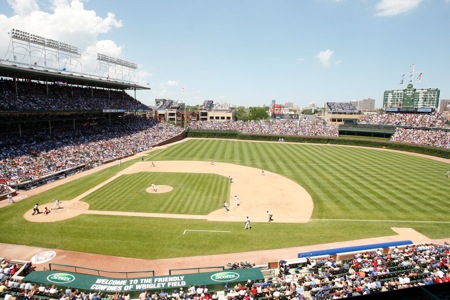
Courtesy Chicago Cubs
When the Chicago Cubs win a game, they fly a white flag with a blue W on it from atop the stands at Wrigley Field, their historic ballpark on the north side of Chicago.
The winners of the annual Indianapolis 500 and Brickyard 400 races at the Indianapolis Motor Speedway and their crews traditionally kiss the yard-wide strip of bricks at the start/finish line that are from the century-old raceway’s original surface.
When a Green Bay Packer scores a touchdown at Lambeau Field, he often jumps jubilantly into the end zone seats to be mobbed by adoring fans.
Sports venues in the Heartland of America offer a rich tapestry of traditions that groups can experience either at games or on tours of the ballparks, stadiums and racetracks.
Groups can cheer about the following sample of sports venues in the Heartland states.
Wrigley Field
Chicago
One of the most iconic sports venues in the country is Wrigley Field, the second-oldest major league ballpark, which is famous for its hand-operated scoreboard, ivy-covered outfield walls and die-hard bleacher fans who toss back opposing teams’ home run balls.
Groups who can’t attend a game can get a thorough tour of the historic field from spring through fall.
“On a tour, we give people a little history and take them to all areas of the park,” said John Oboikowitch, a tour guide and Cubs Ambassador. “We get a lot of out-of-towners, and we universally get a lot of credit and appreciation for the fact they get to see so much of the field.
“We go to the press box, both locker rooms, into the dugout and bleachers. They get to see the manual scoreboard and get on the field. They really like to get down to the field. It is a real treat for fans to get on the warning track and sit in the dugout.”
Oboikowitch noted that Wrigley Field was originally built in 1914 for the Federal League, a short-lived competitor to the National and American leagues. The Cubs moved in two years later and have been there ever since.
The park was named Wrigley Field in 1927 after longtime owner P.K. Wrigley.
“It is very much a neighborhood facility,” said Oboikowitch. “A culture has grown up around it.”
www.cubs.com
773-404-4734
Indianapolis Motor Speedway
The massive Indianapolis Motor Speedway, whose original brick racing surface was built in 1909, is the world’s largest spectator sporting facility, with more than 250,000 permanent seats. The infield of its racing oval covers 253 acres.
The Speedway has been the site of the Memorial Day weekend Indianapolis 500 for 100 years — the race marked its centennial this year — and of the NASCAR Brickyard 400 for nearly 20 years.
From March through November, groups can get a glimpse of the excitement that goes on behind the scenes on race days with a tour of the grounds that takes visitors to areas normally open only to officials, drivers and teams.
The tour includes the timing-and-scoring suite in the 13-story Pagoda, one of the track’s most recognizable structures; the media center; the victory podium; and the Gasoline Alley garage area.
The 90-minute tour also makes a trip around the 2.5-mile oval in special buses and a stop at the “yard of bricks.”
The Indianapolis Motor Speedway Hall of Fame and Museum, which is in the infield, is part of the tour.
The museum has approximately 75 historic vehicles on display at any one time. Among the more than 30 Indy 500-winning cars is the Marmon Wasp, which won the inaugural Indianapolis 500 in 1911.
The museum displays also feature historic equipment, driver memorabilia and a large trophy collection.
www.brickyard.com
317-492-6747










